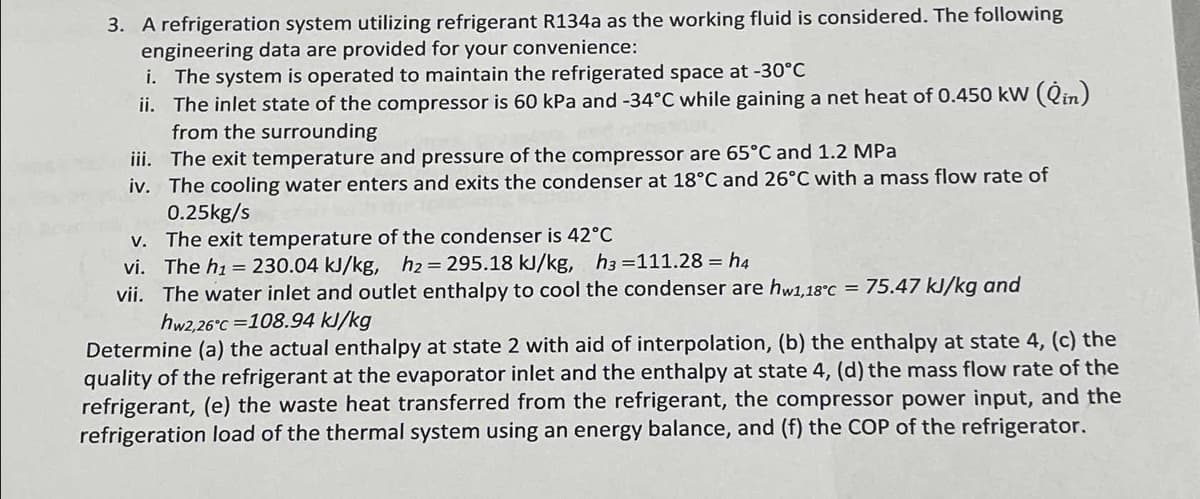3. A refrigeration system utilizing refrigerant R134a as the working fluid is engineering data are provided for your convenience: i. The system is operated to maintain the refrigerated space at -30°C ii. The inlet state of the compressor is 60 kPa and -34°C while gaining a net heat of 0.450 kW (Qin) from the surrounding iii. The exit temperature and pressure of the compressor are 65°C and 1.2 MPa iv. The cooling water enters and exits the condenser at 18°C and 26°C with a mass flow rate of 0.25kg/s v. The exit temperature of the condenser is 42°C vi. The h₁ = 230.04 kJ/kg, h2 = 295.18 kJ/kg, h3=111.28 = h4 vii. The water inlet and outlet enthalpy to cool the condenser are hw1,18°c = 75.47 kJ/kg and hw2,26°C 108.94 kJ/kg etermine (a) the actual enthalpy at state 2 with aid of interpolation, (b) the enthalpy at state 4, (c) the ality of the refrigerant at the evaporator inlet and the enthalpy at state 4, (d) the mass flow rate of the frigerant, (e) the waste heat transferred from the refrigerant, the compressor power input, and the Frigeration load of the thermal system using an energy balance, and (f) the COP of the refrigerator.
3. A refrigeration system utilizing refrigerant R134a as the working fluid is engineering data are provided for your convenience: i. The system is operated to maintain the refrigerated space at -30°C ii. The inlet state of the compressor is 60 kPa and -34°C while gaining a net heat of 0.450 kW (Qin) from the surrounding iii. The exit temperature and pressure of the compressor are 65°C and 1.2 MPa iv. The cooling water enters and exits the condenser at 18°C and 26°C with a mass flow rate of 0.25kg/s v. The exit temperature of the condenser is 42°C vi. The h₁ = 230.04 kJ/kg, h2 = 295.18 kJ/kg, h3=111.28 = h4 vii. The water inlet and outlet enthalpy to cool the condenser are hw1,18°c = 75.47 kJ/kg and hw2,26°C 108.94 kJ/kg etermine (a) the actual enthalpy at state 2 with aid of interpolation, (b) the enthalpy at state 4, (c) the ality of the refrigerant at the evaporator inlet and the enthalpy at state 4, (d) the mass flow rate of the frigerant, (e) the waste heat transferred from the refrigerant, the compressor power input, and the Frigeration load of the thermal system using an energy balance, and (f) the COP of the refrigerator.
Refrigeration and Air Conditioning Technology (MindTap Course List)
8th Edition
ISBN:9781305578296
Author:John Tomczyk, Eugene Silberstein, Bill Whitman, Bill Johnson
Publisher:John Tomczyk, Eugene Silberstein, Bill Whitman, Bill Johnson
Chapter22: Condensers
Section: Chapter Questions
Problem 7RQ: When a standard-efficiency air-cooled condenser is used, the condensing refrigerant will normally be...
Related questions
Question
Not Ai generated please show all steps
Instead of enthalpy its internal energy

Transcribed Image Text:3. A refrigeration system utilizing refrigerant R134a as the working fluid is considered. The following
engineering data are provided for your convenience:
i. The system is operated to maintain the refrigerated space at -30°C
ii. The inlet state of the compressor is 60 kPa and -34°C while gaining a net heat of 0.450 kW (Qin)
from the surrounding
iii. The exit temperature and pressure of the compressor are 65°C and 1.2 MPa
iv. The cooling water enters and exits the condenser at 18°C and 26°C with a mass flow rate of
0.25kg/s
v. The exit temperature of the condenser is 42°C
vi. The h₁ = 230.04 kJ/kg, h₂ = 295.18 kJ/kg, h3 =111.28 = h4
vii. The water inlet and outlet enthalpy to cool the condenser are hw1,18°C = 75.47 kJ/kg and
hw2,26°C 108.94 kJ/kg
Determine (a) the actual enthalpy at state 2 with aid of interpolation, (b) the enthalpy at state 4, (c) the
quality of the refrigerant at the evaporator inlet and the enthalpy at state 4, (d) the mass flow rate of the
refrigerant, (e) the waste heat transferred from the refrigerant, the compressor power input, and the
refrigeration load of the thermal system using an energy balance, and (f) the COP of the refrigerator.
Expert Solution
This question has been solved!
Explore an expertly crafted, step-by-step solution for a thorough understanding of key concepts.
Step by step
Solved in 3 steps with 20 images

Knowledge Booster
Learn more about
Need a deep-dive on the concept behind this application? Look no further. Learn more about this topic, mechanical-engineering and related others by exploring similar questions and additional content below.Recommended textbooks for you

Refrigeration and Air Conditioning Technology (Mi…
Mechanical Engineering
ISBN:
9781305578296
Author:
John Tomczyk, Eugene Silberstein, Bill Whitman, Bill Johnson
Publisher:
Cengage Learning

Principles of Heat Transfer (Activate Learning wi…
Mechanical Engineering
ISBN:
9781305387102
Author:
Kreith, Frank; Manglik, Raj M.
Publisher:
Cengage Learning

Refrigeration and Air Conditioning Technology (Mi…
Mechanical Engineering
ISBN:
9781305578296
Author:
John Tomczyk, Eugene Silberstein, Bill Whitman, Bill Johnson
Publisher:
Cengage Learning

Principles of Heat Transfer (Activate Learning wi…
Mechanical Engineering
ISBN:
9781305387102
Author:
Kreith, Frank; Manglik, Raj M.
Publisher:
Cengage Learning